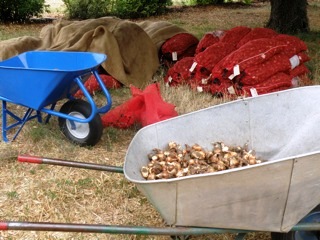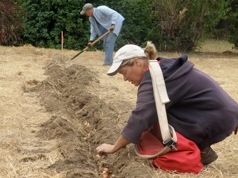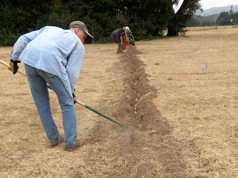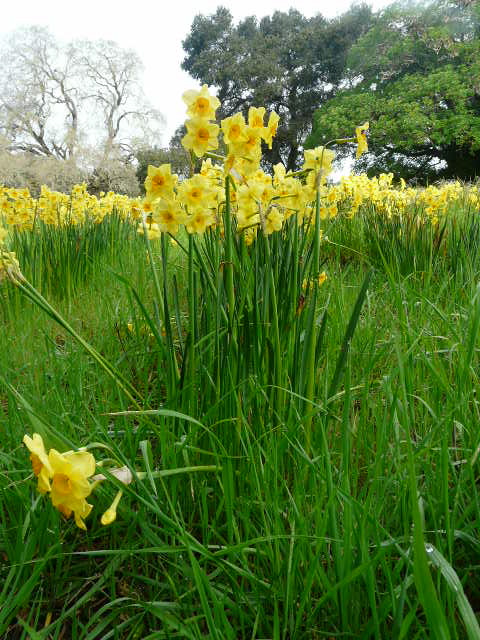

Contributor
- Topics: Archive
Brilliant fields of blooming daffodils are an important part of Filoli’s spring display, blooming in sequence from early February through May, in a color scheme that complements the surrounding permanent woody plants and other bulb companions. The collection includes modern and ancient cultivars as well as English, historic, and many award winning varieties. Over the years Filoli gardeners have learned specific gardening practices not necessarily covered in general books on gardening with daffodils to orchestrate this seasonal splendor.
Field Naturalizing
Planting a field of 75,000 bulbs is quite different than planting a few dozen at a time. For large scale naturalizing we plant into the native soil with no amendments, and no fertilizer. With thousands to plant, a ride-on trencher is not only desirable, it makes the job possible. Following tradition, field daffodils at Filoli are planted in long straight rows set 18 inches apart. Garden volunteers help staff to distribute the bulbs evenly in the trenches on 6-inch centers. The depth of the trench should be two to three times the height of the bulb so planting depths vary from four to eight inches depending on the size of the bulb. Daffodils planted in early fall are left dry until the first rains settle them in.
Along roadsides, daffodils are planted in generous drifts of 250-500 bulbs of a single variety. Plantings within garden borders are smaller but never less than 25 bulbs of a single variety. Soil is first excavated to a depth of about six inches and reserved to one side. Bulbs are spread out 6-inches apart in the shallow pit and backfilled with the reserved soil to cover. Alternatively, clumps of bulbs are planted individually using a battery-powered drill with a wide bit for making holes six inches deep and six inches apart. For planting small clumps of up to 100 bulbs a long handled professional bulb planter with a tapered auger is used by pushing the tool into the ground by foot.
Daffodils are planted as soon as they arrive from the supplier so they are in the ground and ready to start rooting when the rains begin. If planting is delayed to allow the first rains to soften the soil and ease planting, bulbs are held in cold storage at 45 degrees.
A Filoli method of planting daffodils around oak trees has been developed to protect tree roots from unnecessary disturbance. Gardeners lay the bulbs on the surface of the soil outside the tree’s canopy where the plants will receive full sun and cover them with four to six inches of moist compost made on site, mulch, or wood chips. The bulbs root down into the native soil and become established in a year’s time.
[sidebar]
Choose from the following list of fragrant tazettas, old fashioned jonquils, and species daffodils for suitable for naturalizing:
- Autumn Colors Group
- Avalanche of Gold
- Campernelle
- Chinese Sacred lily
- February Gold
- Golden Dawn
- Peeping Tom
- Soleil d’Or
- Sugar Cups
- Sweetness
- The Tenby
- Trevitian
For more information and sourcing check out the Northern California Daffodil Society and the American Daffodil Society. [/sidebar]
Naturalized bulb fields at Filoli survive with no irrigation; the only maintenance they receive is an annual mowing when the foliage has yellowed and turned brown. Filoli does not use herbicides so daffodils must be tall, strong, and vigorous enough to compete with weeds. Fragrant poeticus types like ‘Actaea’ are late blooming but good performers.
Shifting Seasonal Displays
Annual displays in formal garden beds are carefully laid out with garden string lines used to establish tidy rows. Bulbs are individually placed in holes dug with long-handled planters, tips pointing up, carefully backfilled with soil, and overplanted with seasonal bedding plants. Daffodils and tulips bloom first, followed by the bedding plants which fill in to cover the unsightly bulb foliage as it ripens. At the end of the season, the spent bedding plants are removed and bulbs are either left in the beds or dug out the following fall when they are dormant and planted out where they can naturalize.
Filoli purchases approximately 11,000 daffodils each year for container plantings. Twelve to 14-inch clay pots are soaked the day before planting to clean and remove any accumulated salts. Fifteen to 20 bulbs, depending on the size of the bulb, are placed in each pot on a base of three inches of well-drained potting soil, tightly spaced “shoulder to shoulder” for maximum show. Containers are then filled with soil leaving a 2 inch watering well between the lip of the pot and the soil surface, watered well, and placed into cold frames where they are kept moist until foliage starts to emerge. Once leaves are showing and plants are in active growth they must be kept well-watered.
Beginning in late January, pots of the early blooming cultivars are displayed in various areas of the garden and whisked away four to five weeks later as their bloom period is finished. Container plantings allow Filoli the advantage of displaying a continuous sequence of early, mid, and late season daffodils at the same locations throughout the gardens throughout late winter and spring.
Some of the tazettas and paper white narcissus, like ‘Ziva’, and ‘Inbal’, are opportunists not limited by chilling requirements, and immediately initiate growth when watered. Depending on the cultivar, these bulbs are potted up six to seven weeks prior to their desired bloom date and forced in greenhouses to bloom for garden displays and special events. Paper whites held in coolers and potted up in early January are in full bloom when Filoli opens in mid-February beautifully complementing camellias, magnolias and rhododendrons which bloom at the same time. Paper white narcissus are hardy in frost-free regions and may be recycled after forcing and naturalized in gardens where they will bloom in December in subsequent years.
Daffodil bulbs used in seasonal displays later find a permanent home in adjacent fields. Gardeners return daffodil pots to the greenhouse area once bloom is complete. Plants are maintained until leaves begin to turn yellow at which point irrigation is gradually reduced as the foliage turns brown, and soil in the pots is allowed to dry out completely. Each August garden volunteers remove the dried spent foliage, dump the pots and clean the bulbs, before packing them into plastic trays where they remain in cool dry shade until October when it’s time to plant them out on the grounds in a permanent location.
Share:
Social Media
Garden Futurist Podcast
Most Popular
Videos
Topics
Related Posts

Low Maintenance Gardens – Better for Pollinators and People
Autumn 2022 “I come out every day. It’s therapy, my meditation.” Janet’s young garden transformed from overgrown, invasive plants to mostly natives. The dailiness of

Calochortophilia: A Californian’s Love Affair with a Genus
Summer 2022 I can chart the progression of my life by Calochortus. For the last two decades, at least. As a teenage girl growing up

Pacific Plant People: Carol Bornstein
Spring 2022 Public gardens play a key role in demonstrating naturalistic planting design, selecting native and adapted plants for habitat, and testing techniques for reducing

Add Year-Round Interest and Winter Blooms for Pollinators
Spring 2022 This article was created from an Interview by Merrill Jensen with Neil Bell in the Summer of 2021 for our Pacific Plant People














Responses